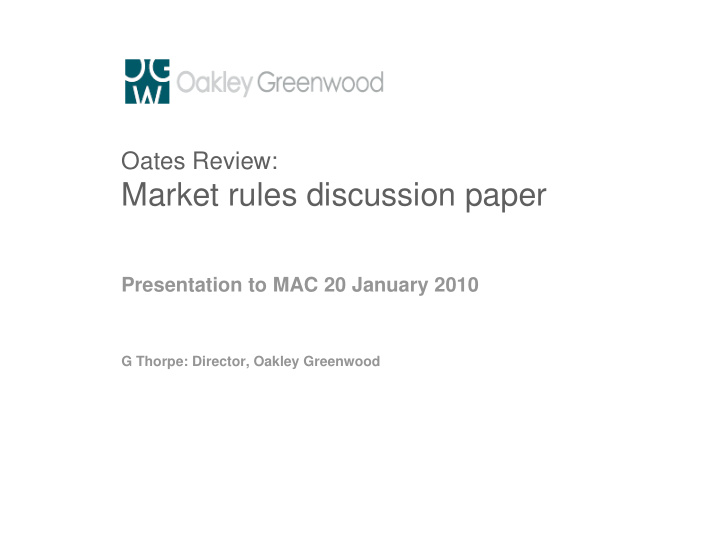



Oates Review: Market rules discussion paper Presentation to MAC 20 January 2010 G Thorpe: Director, Oakley Greenwood
Role of the discussion paper � Primarily a “think piece” � Documents understanding of issues � Documents design perspective � Highlights preliminary views on: “Pinch points” in current design � � Characteristics (but not specifics) of solutions 2
Holistic regulatory/design view � The sector design is formed from the net impact of : � Legislation � Licences � Policy (e.g. Renewables, capacity caps) � Regulations � Market rules � Structure – Ownership, technology mix, fuel supply � Regulatory and operational expertise/training/governance approach – E.g. Laissez faire v heavy handed � Transition arrangements including vesting and displacement All parts play a role – market rules are “glue” between many of the parts 3
Framework � Framework based on analysis of fundamentals of the industry and impact of operation on reliability and efficiency � Market is a tool to deliver � Market implies commercial incentives used to influence behaviour � Commercial incentives = profit motive 4
Starting points � Identified unacceptable outcomes in current arrangements � Verve Review conclusions � IMO market evolution plan � Multi-faceted problem (vesting/displacement, sector strategy, market rules) � Ministerial mandate to address � (for the record) Core market design not under review � No mandate � Avoid throwing “baby out with bathwater” � Repair/evolve implementation of core design – Rules for many market designs are repaired/evolved in first few years � Existing governance process respected � Market rules MUST comply with market objective No bias for or against different participant(s) ! 5
6 Industry steps
7 Settlement $ Using the WEM to deliver industry steps
8 A difficult balance
9 (ref discussion paper) elements linkages design WEM and
10 Focus on short term operations
11 Settlement $ Using the WEM to deliver industry steps
12 Short term operations
WEM cost and revenues (short term operations) � Operating expenditure (including for fuel); � Ancillary Service related expenditure (capital and operating); � Capacity credit revenue; � Capacity credit penalties; � Net revenue from off market bilateral contract trading; � Bilateral contract payments; � STEM trades; � Net DDAP/ UDAP revenue in balancing; � Ancillary service revenue; and � Network charges and market fees; and � Ancillary Service charges 13
Illustrative strawman issues for discussion not intended to be comprehensive at this stage Status Quo Issue Sample options Subject to CBA � Unit IPP: Embedded in resource plans Little chance for STEM gate closure (time and Commitment based on single pass or SM override economic optimisation no.) on tech grounds. Security constrained STEM Verve: Opaque, not optimised with IPP. Little chance for Ancillary Service economic optimisation Pre dispatch Single pass . Basis for security Too late for some fuel assessment but information only for management market Security By SM after market gate closure hence Heavy reliance on Incorporate in STEM Assessment no commercial mechanism for market intervention to address to fix – presumes very few issues ? Dispatch & Based on resource plan Misses economic Broaden option for participation. Balancing Verve as primary balancer options for IPP Balancing support contracts. participation Economic dispatch Settlement Static capacity penalties and all “stick Commercial rewards Adjust magnitude of payments no carrot” and penalties inefficient UDAP, DDAP factors, allocation of (materiality?) hence Anc S charges not cost reflective market missing efficient behaviours 14
WEM Unit Commitment � Non Verve: embedded in STEM submissions and resource plans � Heavily influenced by (bilateral) contract positions � Verve: effectively determined by System Management to meet dispatch/security/balancing requirements � System Management required to consider physical operating conditions � Non Verve IPPs have no price discovery � Essential for efficient unit commitment – Central UC – Multiple passes – Liquid trading 15
Reiterate � Holistic design essential � Market rules � Contract base � Vesting (part of transition) � Regulation – Retail price (including cost reflectivity) – Contestability policy – Network augmentation – Network pricing (quantum and design) � Many aspects of market working in principle � Existing governance structure respected � Practical � Important for credibility of industry 16
17 Now, the hard work !!
Recommend
More recommend